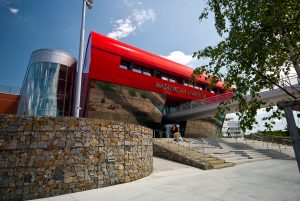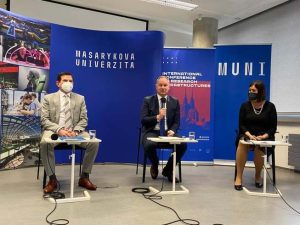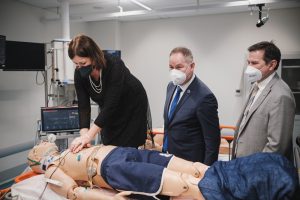Research stakeholders debated the future of large research infrastructures of Czechia
On Tuesday, 15th February 2022, the Masaryk University (MUNI) in close cooperation with the Central European Institute of Technology (CEITEC) hosted already the 5th edition of the National Day of Large Research Infrastructures of Czechia – the annual event organised by the Ministry of Education, Youth and Sports (MEYS) to provide Czech research stakeholders with a forum to address pressing challenges of the large research infrastructures agenda development. Due to the persisting SARS-CoV-2/Covid-19 epidemy, and related containment and restriction measures, the conference had to be held in a virtual meeting room with over 300 registered participants following the webstream. Minister of Education, Youth and Sports Petr Gazdík opened the conference programme by outlining the proposal for public funding of large research infrastructures in the upcoming multiannual financial framework 2023–2029. His keynote address was echoed by Martin Bareš, Rector of the Masaryk University, as well as Minister Helena Langšádlová, who shared the views of her newly established Governmental Office for Science, Research and Innovation.
“The high quality of Czech large research infrastructures, and their socioeconomic benefits and impacts must be properly reflected in their public funding. We have to take measures to maintain their position and position of Czechia in the European Research Area and European Research Infrastructure Consortia. The Czech Presidency in the EU Council will place research infrastructures at the centre of the European policy-making in the 2nd half of 2022 with the ambition to adopt the Council Conclusions on Research Infrastructures. Czechia will also host this-year’s International Conference on Research Infrastructures, to be attended by hundreds of research infrastructure stakeholders from all around the world. ICRI 2022 shall feed into the so-called Brno Declaration on Research Infrastructures, calling on the development of a fully integrated global research infrastructure ecosystem. Czech research and political stakeholders shall therefore pay special attention to the future of Czech large research infrastructures,” says Minister of Education, Youth and Sports Petr Gazdík.
Minister of Education, Youth and Sports Petr Gazdík
Monitoring of large research infrastructures in 2021
At the beginning of the morning session of the conference programme, the results of the international peer-review assessment of large research infrastructures of Czechia, which was held by MEYS in 2021, were presented. Afterwards, the Technology Centre of the Czech Academy of Sciences also introduced the outcomes and conclusions from the pilot analysis of socioeconomic benefits and impacts of Czech large research infrastructures (.zip file), based on the information and data covering the period 2016–2020. The elaboration of the pilot analysis was financially supported by MEYS and will be followed by preparation of a comprehensive methodology to monitor the large research infrastructures’ benefits and impacts in long-term. Operators of large research infrastructures were then provided with possibility to present cases studies on how large research infrastructures closely cooperate with businesses and industries, how do they essentially contribute to the SARS-CoV-2/Covid-19 pandemic crisis management, as well as the development of the treatments of Covid-19, and how do they collect data on the socioeconomic impacts of the pandemic.
Masaryk University (MUNI)
Public funding of large research infrastructures in 2023–2029
Following the evaluation exercises organised by MEYS in 2021 to assess the implementation status of the large research infrastructure projects, their performance and deliverables, the Czech Government shall adopt the multiannual financial framework for public funding of the large research infrastructure projects in post-2022. MEYS will draft the proposal for public funding and present it to the Government of Czechia once the state budget expenditures on research, development and innovation for 2023 and the mid-term outlook for 2024 and 2025 have been endorsed and the budgetary envelope determined. It’s of utmost importance to provide the large research infrastructure projects with sufficient, inflation-friendly, reliable and predictable multiannual funding framework that will facilitate long-term financial planning of operations, service provision and upgrades of the facilities, and engaging with international partnerships at the European level and globally.
Central European Institute of Technology (CEITEC)
European research infrastructures coordinated by Czechia
After the lunch break, the audience was informed on the current state-of-play of the implementation of the ELI (Extreme Light Infrastructure) and EIRENE (European Environmental Exposure Assessment Network) European research infrastructure projects, which are coordinated by Czechia. Both of them are listed in the recent ESFRI Roadmap 2021 (Roadmap of the European Strategy Forum on Research Infrastructures), which includes a total of 41 successfully implemented projects of European research infrastructures – ESFRI Landmarks (out of which 25 are participated by Czechia), and a total of 22 ESFRI Projects (out of which 7 are participated by Czech research stakeholders).
Extreme Light Infrastructure (ELI) – ELI Beamlines
Czechia getting ready for the implementation of the EOSC initiative
The conference programme was concluded by an overview of the preparations to implement the EOSC (European Open Science Cloud) initiative in Czechia. The development of a comprehensive, integrated and interoperable data infrastructure for processing, storing, exchanging and sharing of the scientific data nationally and internationally according to the FAIR (Findability, Accessibility, Interoperability and Reusability) principles will be supported by the Operational Programme Johannes Amos Comenius (OP JAK), using the EU Cohesion Policy Funds. Czech research stakeholders therefore gather their expertise, capacities and capabilities to build the central hubs and distributed science-disciplinary repositories of the Czech national data infrastructure under the coordination of the e-INFRA CZ e-infrastructure and the National Library of Technology. The calls for submission of project proposals shall be launched by MEYS already this year once OP JAK has been endorsed by the European Commission.
European Environmental Exposure Assessment Network (EIRENE) – RECETOX Research Infrastructure
Live recording from the conference is available at the YouTube Channel of the Masaryk University.
Research infrastructures are creating an essential network of top-class facilities empowering European scientists to perform ground-breaking fundamental and applied research, which push the horizons of the human knowledge beyond yet known horizons. They are also a platform to develop state-of-the-art technologies with a great potential for application in innovative products and services of high added value. Research infrastructures bring numerous benefits, impacts and spill-overs beyond the scientific area, and facilitate knowledge-based solutions to grand societal and economic challenges. When being involved in the Covid-19 pandemic crisis management, research infrastructures clearly demonstrated their role as a vital component of the critical infrastructure. Preparedness of the research infrastructure ecosystem, thereby, directly effects and determines preparedness of the society to respond to any crisis scenario. Investments in research infrastructures are therefore a highly strategic investment. Research infrastructures, providing their expertise, technological devices and services on the open access policy basis, are also the flagship implementing the Open Science Policy, in which they have irreplaceable role.
Presentations
Photogallery













